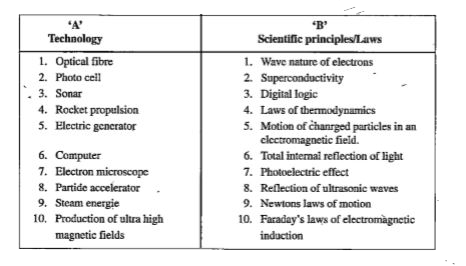Match the technology in column A to its related scientific principle in column B
A - TechnologyB - Scientific Principle1) Steam enginea) Faraday's laws2) Nuclear Reactorb) thermodynamic laws3) Computerc) Nuclear Fission4) electric generationd) Digital logic
1 - b, 2 - d, 3- c, 4 -a
1 - b, 2 - d, 3 - c, 4 - a
1 - a, 2 - c, 3 - d, 4 - b
1 - d, 2 - a, 3 - c, 4 - b
The correct Answer is:B
To solve the question of matching technologies in column A to their related scientific principles in column B, we will analyze each technology and identify the corresponding scientific principle.
1. Identify the Technologies:
- 1) Steam engine
- 2) Nuclear Reactor
- 3) Computer
- 4) Electric generation
2. Identify the Scientific Principles:
- a) Faraday's laws
- b) Thermodynamic laws
- c) Nuclear Fission
- d) Digital logic
3. Match Each Technology with the Correct Principle:
- Steam engine: The steam engine operates based on the principles of thermodynamics, specifically the conversion of heat energy into mechanical work.
- Match: Steam engine - b) Thermodynamic laws
- Nuclear Reactor: A nuclear reactor operates on the principle of nuclear fission, where the nucleus of an atom splits into smaller parts, releasing a significant amount of energy.
- Match: Nuclear Reactor - c) Nuclear Fission
- Computer: Computers operate on the principles of digital logic, which involves binary numbers and logic gates to perform calculations and process information.
- Match: Computer - d) Digital logic
- Electric generation: Electric generation often involves electromagnetic induction, which is described by Faraday's laws of electromagnetic induction.
- Match: Electric generation - a) Faraday's laws
4. Final Matching:
- 1) Steam engine - b) Thermodynamic laws
- 2) Nuclear Reactor - c) Nuclear Fission
- 3) Computer - d) Digital logic
- 4) Electric generation - a) Faraday's laws
Summary of Matches:
- 1) Steam engine - b) Thermodynamic laws
- 2) Nuclear Reactor - c) Nuclear Fission
- 3) Computer - d) Digital logic
- 4) Electric generation - a) Faraday's laws
---
- 1) Steam engine
- 2) Nuclear Reactor
- 3) Computer
- 4) Electric generation
- a) Faraday's laws
- b) Thermodynamic laws
- c) Nuclear Fission
- d) Digital logic
- Steam engine: The steam engine operates based on the principles of thermodynamics, specifically the conversion of heat energy into mechanical work.
- Match: Steam engine - b) Thermodynamic laws
- Nuclear Reactor: A nuclear reactor operates on the principle of nuclear fission, where the nucleus of an atom splits into smaller parts, releasing a significant amount of energy.
- Match: Nuclear Reactor - c) Nuclear Fission
- Computer: Computers operate on the principles of digital logic, which involves binary numbers and logic gates to perform calculations and process information.
- Match: Computer - d) Digital logic
- Electric generation: Electric generation often involves electromagnetic induction, which is described by Faraday's laws of electromagnetic induction.
- Match: Electric generation - a) Faraday's laws
- 1) Steam engine - b) Thermodynamic laws
- 2) Nuclear Reactor - c) Nuclear Fission
- 3) Computer - d) Digital logic
- 4) Electric generation - a) Faraday's laws
- 1) Steam engine - b) Thermodynamic laws
- 2) Nuclear Reactor - c) Nuclear Fission
- 3) Computer - d) Digital logic
- 4) Electric generation - a) Faraday's laws
Topper's Solved these Questions
- PHYSICAL WORLDBook:AAKASH SERIESChapter:PHYSICAL WORLDExercise:Exercise -I
Explore 10 Videos
- PHYSICAL WORLDBook:AAKASH SERIESChapter:PHYSICAL WORLDExercise:Exercise -I
Explore 10 Videos
- OPTICAL INSTRUMENTS Book:AAKASH SERIESChapter:OPTICAL INSTRUMENTS Exercise:PRACTICE SHEET (EXERCISE -I) (OPTICAL INSTRUMENTS) (LEVEL-I (MAIN)) (SUBJECTIVE OBJECTIVE TYPE QUESTIONS)
Explore 21 Videos
- PRACTICAL PHYSICSBook:AAKASH SERIESChapter:PRACTICAL PHYSICSExercise:LECTURE SHEET LEVEL-II (ADVANCED) Linked Comprehension Type Questions
Explore 4 Videos
Similar Questions
Match the technology in column A to the corresponding scientific principles/laws in Column B.

View SolutionMatch the scientist's name against discovery
A - ScientistB - Discovery1) Faradaya) Expansion of Universe2) Newtonb) Law of EMI3) Einsteinc) Law of gravitation4) Hubbled) Theory of relativity
View SolutionMatch the following columns and Choose the correct combination from the given option :
Column - IColumn - II(A) Plantae(1) Bacteria(B) Fungi(2) Euglenoids(C) Protista(3) Phycomycetes(D) Monera(4) Algae
View SolutionMatch the column I with column II and choose the correct combination from the option given:
Column -I Column-II(1)Deuteromycetes(A) Morels(2) Ascomycetes(B)Smut(3) Basidiomycetes(C) Bread mould(4)Phycomycetes(D)Imperfect fungi
View SolutionMatch the items in colour I with items in column II and choose the correct option.
Column-IColumn-II(A) Triglyceride(1) Animal hormones(B) Membrane lipid(2) Feathers and leaves(C) Steroid(3) Phospholipids(D) Wax(4) Fat stored in the form
View SolutionMatch the hormones with its source of secretion :
Column - IColumn - II(A) Somatostatin(1) Pineal gland(B) Melatonin(2) Pancreas(C) Aldosterone(3) Placenta(D) Erythropoietin(4) Adrenal cortex(E) hCG(5) Kideny(6) Liver
View SolutionMatch the following in column A with the correct answer form the choices given in column B:
Column A: 1. Ammonium hydroxide soln., 2. Dilute hydrochloric acid, 3. Carbon tetrachloride
Column B: A:Contains only ions, B: Contains only molecules, C: Contains ions & molecules
View SolutionMatch the following column I with column II .
Column - IColumn - IIA - Metaphase - II1. Centromere with 2 kinetochoresB. Anaphase -I2. DisjunctionC. Mitosis3. SynapseD. Zygotene4. Plectonemic coiling
View SolutionMatch the items in column 1 with the items in column 2.Column 1 Column 2(i) 35 (a) Multiple of 8(ii) 15 (b) Multiple of 7(iii) 16 (c) Multiple of 70(iv) 20 (d) Factor of 30 (v) 25 (e) Factor of 50 (f) Factor of 20
View SolutionMatch Column -I with Column -II select the correct option from the codes given below .
Column -I (Scientific name )Column -II (Common name )(a)Chelone (i)Turtle (b)Testudo(ii)Tortoise(c)Calotes(iii)Tree lizard(d)Chamaelon(iv)Garden lizard
View Solution
